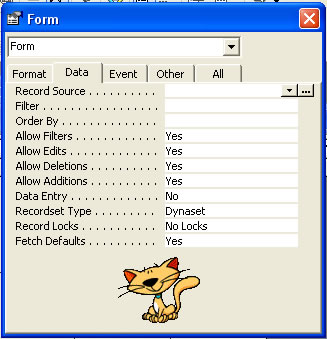
Tip |
If you make a mistake in design view (such as deleting a control you meant to keep), just close the form and click No when Access asks if you want to save changes.
Note |
AutoFormats are stored in Access itself, not in individual databases. So, if you create a new AutoFormat in one database, you can use it in your database.

Properties Window of the Form Object
Five tabs appear at the top of the Properties window. As you click these tabs, the window displays different sets of properties. These tabs are as follows:
Format - Properties that control the appearance of the selected item.
Data - Properties that control the data displayed by the selected item.
Event - Properties that control the code executed by the selected item.
Other - Properties that don't fit into one of the three previous classes
All - All the properties of the item in one big list.
Properties of An Access Form Explanation:-
| Properties of an Access Form | |
| Property | Meaning |
| Record Source | The table or query from which the form gets its data |
| Caption | The text displayed at the top of the form |
| Allow Edits | Controls whether the form can be used to edit data |
| Allow Deletions | Controls whether the form can be used to delete data |
| Allow Additions | Controls whether the form can used to add data |
| Scroll Bars | Controls whether scrollbars appear on the form |
| Record Selectors | Controls whether record selectors (the bars to the left of the data) appear on the form |
| Navigation Buttons | Controls whether the navigation bar appears at the bottom of the form |
| Dividing Lines | Controls whether the form automatically resizes to show all its controls when it is opened. |
| Auto Center | Controls whether the form is automatically centered on the screen. |
| Picture | The picture (if any) to use for the form's background |
| Picture Size Mode | Specifies whether any background picture should be stretched to fill the form. |
| Picture Tiling | Controls whether any background picture should be repeated to fill the form. |
| Moveable | Controls whether the form can be moved onscreen after it has been opened. |
Caution |
Note |
In Access, a control that is attached to data is called a bound control. A control that is independent of data is called an unbound control.
Tip |
When you're learning your way around design mode, the Control Wizards can save you a lot of time.
Tip |
To change the background color of a form that doesn't have a picture for a background, select the detail section of the form and edit its Back Color property.